What is white asparagus and why is it that color
The popularity of asparagus is increasing every day due to its taste and health benefits. There are three varieties: green, white and purple. White asparagus deserves the highest tasting rating. Let's talk about its beneficial qualities, planting and care features, and find out if a healthy vegetable can harm you.
The content of the article
What is White Asparagus
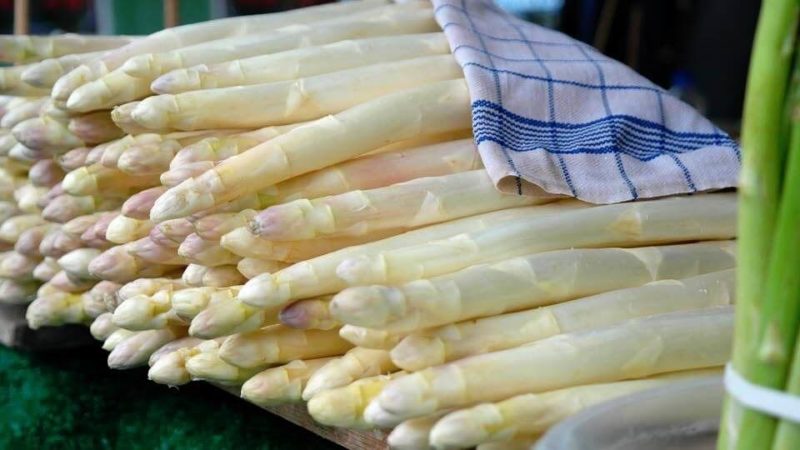
The first mentions of white asparagus are found among the ancient Egyptians and date back more than 4 thousand years ago. At some point, the plant was appreciated at the courts of European kings. For a long time, asparagus was considered the food of aristocrats, but gradually it began to enter the diet of less noble people. In Russia, asparagus appeared during the tsarist empire. It was appreciated at its true worth recently, so the popularity of asparagus is only growing.
White asparagus (asparagus) is a hardy dioecious plant. Asparagus blooms in the second year, subsequently forming red ball-fruits. An adult plant has a powerful root system. Roots are formed at each new shoot. Under favorable conditions, asparagus can live up to 20-25 years. Young shoots up to 12 cm long are eaten.
What is different from green and why is it white
The color of the asparagus depends on the degree of its growth. White shoots are the youngest, located underground, delicate in taste and soft. After the shoots break through, they begin to change color under the influence of the sun, acquiring a purple or purple hue. Gradually the color darkens and turns green. Many people believe that harvesting is possible only at this time, but asparagus is edible at all stages of growth.
How white asparagus grows can be seen in the photo.
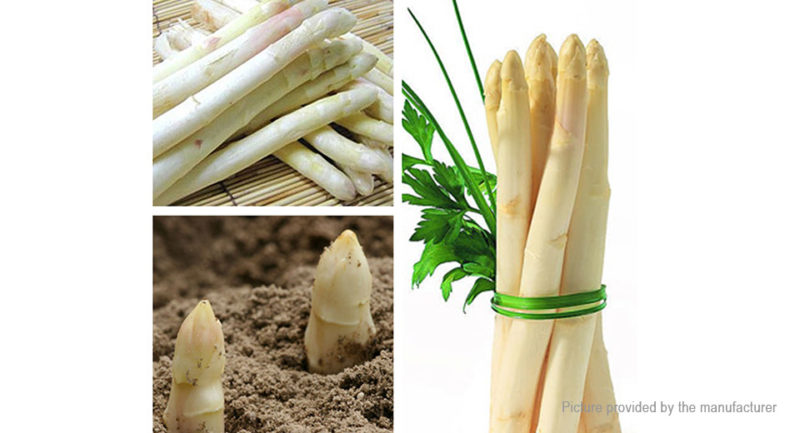
Chemical composition, trace elements and vitamins
Asparagus has a rich chemical composition and contains many useful substances.
Vitamins:
- vitamin PP - 1 mg;
- beta-carotene - 0.5 mg;
- vitamin A (RE) - 83 mcg;
- vitamin B1 (thiamine) - 0.1 mg;
- vitamin B2 (riboflavin) - 0.1 mg;
- vitamin C - 20 mg;
- vitamin E (TE) - 2 mg;
- vitamin PP (niacin equivalent) - 1.4 mg.
Macronutrients:
- calcium - 21 mg;
- magnesium - 20 mg;
- sodium - 2 mg;
- potassium - 196 mg;
- phosphorus - 62 mg.
Trace elements:
- iron - 0.9 mg;
- copper - 0.17 mg;
- manganese - 0.15 mg;
- selenium - 6.1 mcg;
- fluorine - 21.9 mcg;
- zinc - 0.6 mg.
Calorie content and BZHU
The plant is suitable for diet food due to its low calorie content - only 20 kcal per 100 g of product.
The composition of the BZHU:
- proteins - 1.9 g;
- fats - 0.1 g;
- carbohydrates - 3.1 g.
Useful properties for the human body
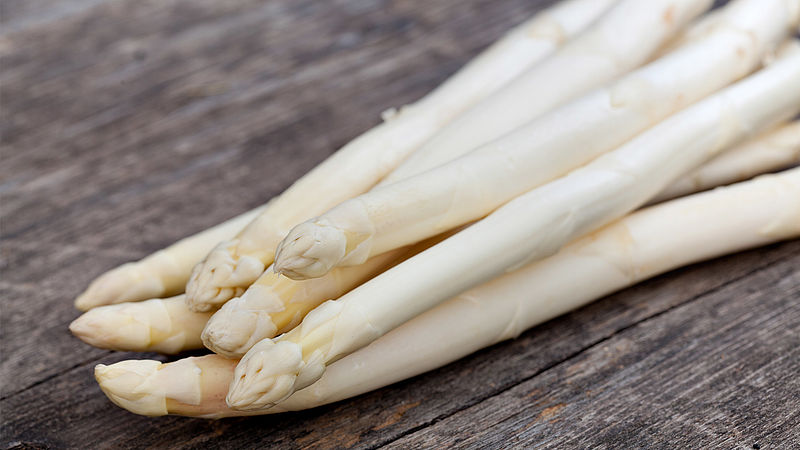
Asparagus is valuable to humans due to a number of beneficial qualities:
- this low-calorie product is suitable for proper and dietary nutrition;
- removes excess fluid from the body;
- supports the work of the cardiovascular system due to the high content of asparagine;
- cleanses the intestines;
- enhances potency;
- strengthens bone tissue, builds connective tissue, therefore it is recommended for baby food;
- regulates blood cholesterol;
- recommended during pregnancy, helps the fetus to form properly.
Features of planting and growing
To make asparagus happy with a good harvest, you must adhere to the rules of planting and caring for it. Asparagus is planted in two ways: seed and seedling. The second is considered the most effective.
When is the best time to plant
Asparagus seeds take a long time to germinate, so it is recommended to prepare seedlings in advance, from mid-March.
Seed preparation
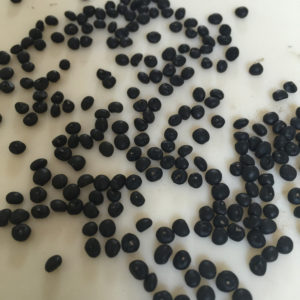
First, exclude damaged seeds. Inspect them and discard any that show obvious signs of damage, rot, or mold. Dip the seeds into the water. Full, suitable for planting, will sink to the bottom of the container, and the sterile ones will remain on the surface.
Pour the selected seeds for 2-3 days with warm water with the addition of a growth stimulant (a few drops of a pale pink solution of potassium permanganate, "Epin Extra", "Energen"). Move them to a warm place, change the water twice a day. Next, wrap the swollen seeds in a damp cloth or burlap (it must be moistened regularly) and keep them in this form for 5-7 days, until the first sprouts of 1-3 mm hatch.
It is interesting:
Varieties of asparagus: thin-leaved, argentel and others
Tank preparation
For asparagus seedlings, special boxes or plastic cups with a volume of 100-200 ml are required (several holes must be made in them to drain the water).
The soil
Grow asparagus in loose and light soil. A mixture of garden soil, manure, peat and sand in equal parts is best suited.
Sowing in a container
The seeds are immersed in the ground to a depth of 2 cm. Place one seed in each cup. If boxes are used for seedlings, a distance of 5-6 cm is maintained between the seeds. The containers are placed in the sun, observing a temperature regime of + 25 ° C. The soil is moistened every day. As soon as the seeds germinate, they are sprinkled with peat, and the temperature is reduced to + 20 ° C. Two weeks later, the seedlings are fertilized, the soil is regularly loosened for a month (before each watering). To ensure uniform growth, the container with seedlings is turned towards the sun every day.
Important! Before planting, you need to harden the seedlings. To do this, the seedlings are taken outside in warm and sunny weather. Start from 30-60 minutes, gradually increasing the time to 12 hours.
Picking
If the seeds are planted in boxes, the seedlings must be dived. As soon as it grows to 15 cm, it is moved to separate spacious containers. At the same time, the root is shortened. A distance of 10 cm is maintained between the bushes.
Site preparation
Asparagus is a perennial plant. In order for it to consistently please with a good harvest, you need to responsibly approach the choice of the site:
- the site must be well lit and protected from drafts and wind;
- stagnation of water is unacceptable, therefore, groundwater is not higher than 1.5 m;
- the beds are cleared of weeds and debris;
- in the fall, the soil should be dug up and fertilized with compost (15-20 kg per 1 sq. m), potassium sulfate (40 g per 1 sq. m) and superphosphate (70 g per 1 sq. m);
- in early spring, after the snow melts, the land is harrowed and each square. m fertilized with 20 g of ammonium nitrate and 60 g of wood ash. This will destroy the overwintered pest larvae and pathogenic bacteria.
Rules for planting seedlings in the ground
When planting asparagus, follow the following algorithm:
- Move the seedlings into open ground after they have grown to 15 cm.
- Disembark in late April - early June (depending on the region), when the ground warms up enough.
- For seedlings, prepare pits 30 cm deep and 40 cm wide.Leave a gap of 50-60 cm between the bushes.
- Loosen the bottom of the furrow to 20 cm.
- At the bottom, form a slide of loose soil. The height of the slide should match the edge of the hole.
- Reduce the root of the seedling by 4 cm, then place the seedling on the top of the slide.
- Sprinkle the hole, tamp the soil and water.
- Wait until moisture is absorbed and sprinkle with dry earth on top.
- After planting, form a bed with a height of 6 to 8 cm, and the next year, raise it to 60 cm.
Growing white asparagus
The rules for caring for asparagus are not complicated. They consist in simple agronomic techniques.
Watering
Water the asparagus frequently as the soil dries. Use small amounts of warm water. Stagnation of moisture is unacceptable, this will lead to decay of the root system.
Attention! During a dry period, the soil must not be allowed to dry completely, otherwise the shoots of white asparagus will be tough and bitter.
Top dressing
You need to feed asparagus regularly, throughout the entire growth period:
- A month after planting seedlings, the soil is watered with a mullein solution (5-6 liters of water per 1 kg).
- At the end of June, after harvesting, asparagus is fed with urea, potassium salt and superphosphate (30 g of preparations per 1 sq. M).
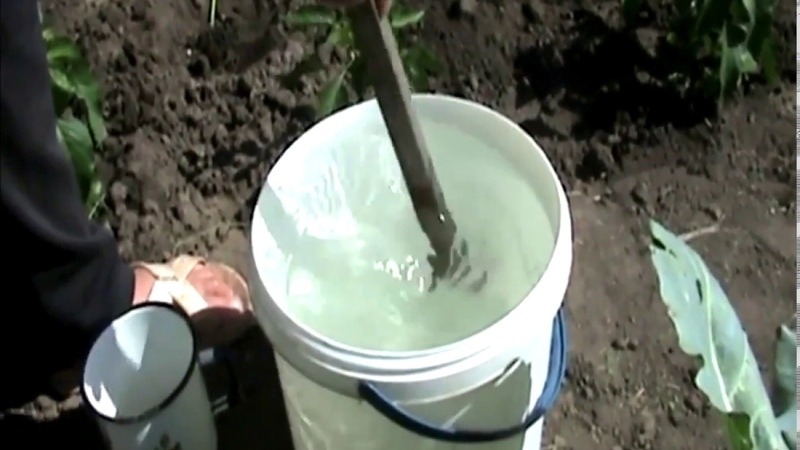
- In early July, organic fertilizers are applied (chicken droppings at the rate of 1 kg per 10 liters of water).
- Before the first night frosts, potassium salt and superphosphate are reintroduced in the same proportions.
Loosening and weeding
Asparagus loves light soil, so loosening is carried out often, after each watering or precipitation, at least 8-10 times per season. Weed beds are weeded every two weeks to avoid disease and pest damage.
Protection against diseases and pests
The main diseases that are dangerous for asparagus:
- Root rot... Not dangerous with a properly selected area and following the rules of watering. In case of minor damage, watering the soil with "Fundazol" (10 g per 10 l of water) will help. If the disease has spread strongly, the plant is dug up and burned outside the site.
- Rust. Formed due to stagnant water and is very dangerous. They fight the disease with timely preventive measures: regular cleaning of weeds, hardening of seedlings, destruction of affected shoots at the first appearance of yellow spots with black dots in the center. After harvesting diseased shoots, the plant is sprayed with Topaz solutions (1 ampoule per 10 liters of water) and Fitosporin-M (diluted according to the instructions).
- Fomoz. Fungal disease due to high humidity. It manifests itself as brown spots with a red border. You can eliminate it with the preparations "Fundazol" and "Fitosporin-M".
- Cercosporosis. Gray spots with a dirty coating. It is important to remove diseased shoots and treat the plants with Fundazol.
- Asparagus flies... Young shoots suffer, inside which adults place eggs. Sick shoots are cut off and burned, in the fall the soil is loosened deeply, preventing the larvae from wintering.
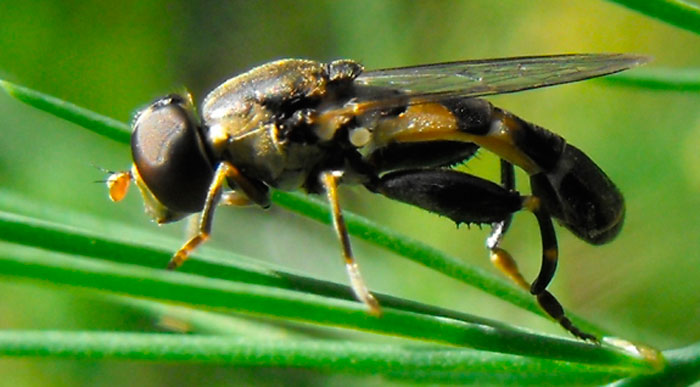 Asparagus flies
Asparagus flies - Asparagus leaf beetle. Eats asparagus leaves and shoots. Before harvesting, it is impossible to treat the plant with drugs, therefore protection consists in the daily morning collection of beetles and their subsequent destruction. After harvesting, asparagus is sprayed with Karbofos (1 ampoule per 10 liters of water).
- Shield. Harms the back of asparagus leaves. Because of this, they dry out and fall off. In such a case, spraying with "Karbofos" helps.
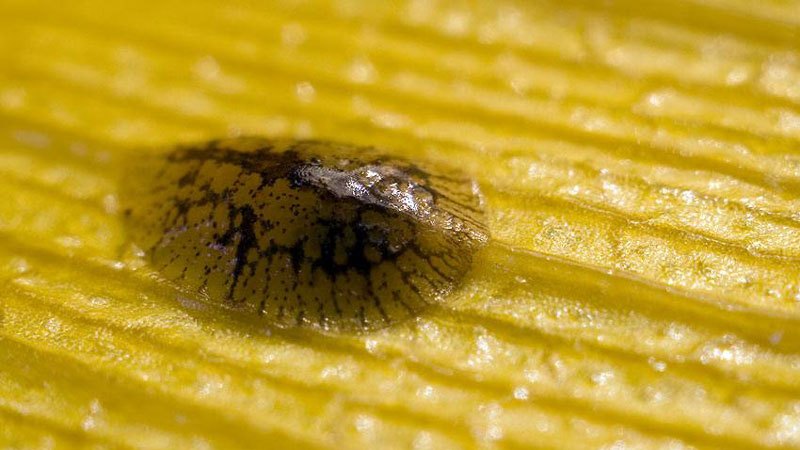 Shield
Shield - Asparagus crackers... They eat young shoots and lay eggs in the ground. For destruction use "Aktellik" (20 g per 10 liters of water), "Aktara" (1 sachet per 3 liters of water), "Karate" (1 g per 10 liters of water).
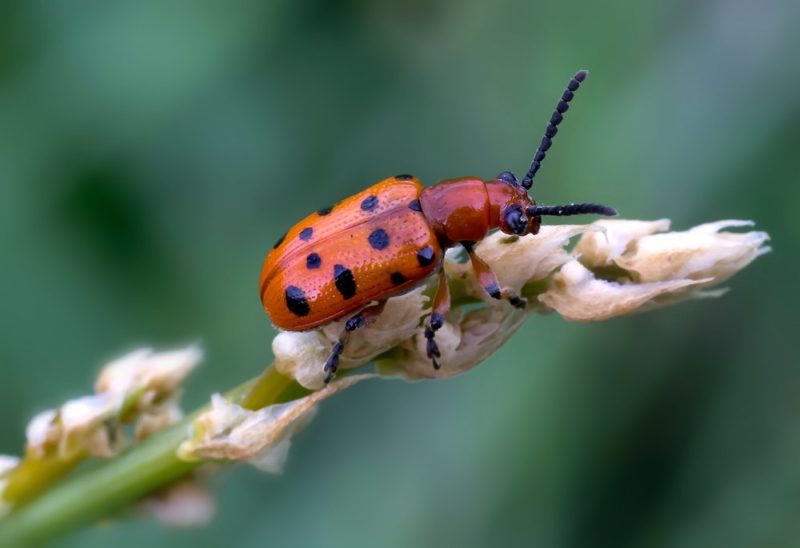 Asparagus rattle
Asparagus rattle
An effective preventive measure against pests will be spraying asparagus during flowering with the Komandor insecticide (2 ml per 5 liters of water).
Harvesting and storage
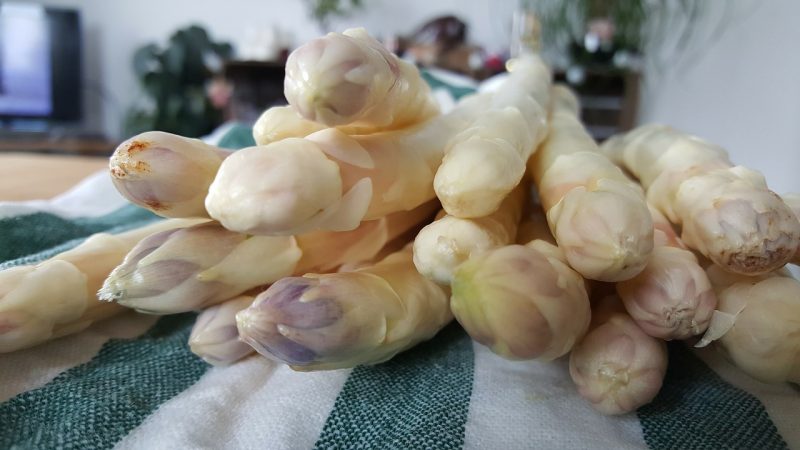
White asparagus is harvested in the third year after planting:
- The collection is carried out from April to June.
- The crust of the earth should lift and crack. The soil is carefully raked, a shoot is found and cut off, leaving 2-3 cm at the base.
- The holes are covered with earth and watered.
- Shoots are harvested as soon as they are ready, every 2-3 days, for a month.
- In the third year of life, asparagus are cut off to five shoots, later - up to 15.
- The crop is harvested early in the morning or in the evening so that the shoots do not darken.
- They should be stored in a dark place, at a temperature not higher than + 3 ° C, in special baskets covered with damp burlap or cloth.
- White asparagus withers quickly, so it is stored for no longer than 3-4 days.
Possible harm and contraindications to eating white asparagus
White asparagus can cause allergies, so you should start getting to know it with caution.
You should refuse to use it when:
- diabetes mellitus;
- rheumatism;
- urolithiasis;
- cystitis.
Conclusion
Due to its delicate taste and rich chemical composition, asparagus is rightfully considered a valuable product suitable for dietary and baby food. It is recommended to plant it in a seedling way, however, in warm regions, prepared seeds can also be placed in the soil. The harvest begins in the third year.
Asparagus needs regular watering and feeding throughout its life. Do not neglect preventive measures in the form of loosening and weeding the beds - this will help to avoid problems with pests and diseases.